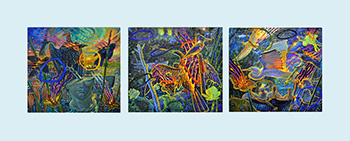
Hanging Artwork

Since the time I took home-science in the seventh grade, the rules for interior decoration and picture hanging have included symmetry, balance, rhythm, line, color, scale and proportion.
Personal taste and a loving touch are required to add uniqueness and quality to a space, whether it is used as an office, hotel, meeting place or home.
Color
In selecting artwork to display, you may ask, does the artwork need to match the interior or furniture? Usually, professional interior decorators try to match the color palette of the upholstery, carpet, curtains and paintings.
If the house has young people with modern ideas living in it, choose abstract art with a matching color palette to follow the rules. To break the rules, choose art based on what speaks to you. A work of abstract art with a contrasting color palette can bring life and interest to family gatherings.
Symmetry and Balance

Square Vase by artist Mark Messersmith 16x16 inches each
For symmetry and balance, artwork is arranged mirrored or anchored along the central axis. This custom is followed to convey stability and dignity.
To follow the rules, arrange one oversized horizontal picture above a couch. To break them — try positioning one big vertical artwork to the left and two smaller works aligned vertically to the right. This type of arrangement can create interest and the host can pick and display more of her favorite artworks, rather than relying on one large piece that might be difficult to store and move.
Height and Distance
Generally, you do not want to scatter the artwork with large gaps between them.
While hanging multiple piece of art, place the large piece in the center as an anchor and arrange several smaller pieces around it. The center of the arrangement placed around 60 inches above the ground is optimal.
A single artwork at eye level is appealing, but height must be adjusted according to the furniture. You do not want to place works of art too high, because they may look disconnected with the furniture. Ideally, large artwork would be placed approximately five inches above the furniture to ensure visual flow.
Also, be sure to provide more space between larger and medium pieces — about 3 inches — and a smaller space between smaller artworks — about 2 inches.
Creativity

A Study Series by artist Mark Messersmith 30x30 inches each
Be creative in your placement of pictures and artwork. For example, various pictures of family milestones or the children in different stages of growth can be displayed along stairways. As you climb the stairs, you will see your children grow from infancy to adolescence and adulthood. Alternately, choose artwork that tells a progressive story or suggests evolution, example Dasavatara, while ascending to the top.
Do not be afraid to make your own rules to customize the space according to your unique taste. For example, you can forgo the frame for well-stretched artwork with finished sides. Lightweight works can be hung with simple adhesive or Velcro. Or you can skip hanging the art altogether, and simply lean it on a shelf or the mantle.
Brinda Pamulapati, owner/managing director, of Venvi Art Gallery in Tallahassee, can be reached at (850) 322-0965 or visit www.VenviArtGallery.com